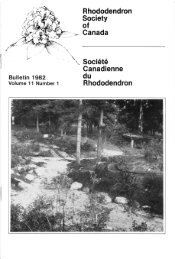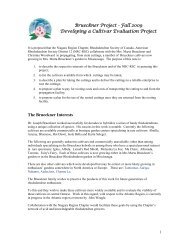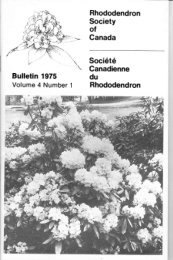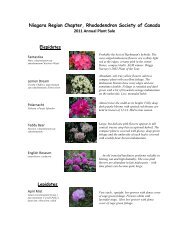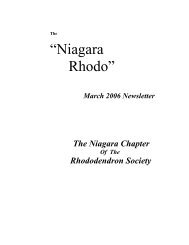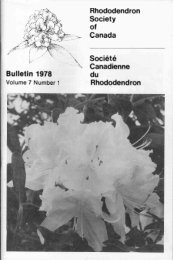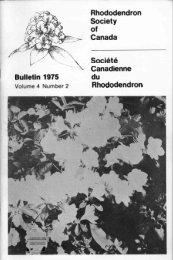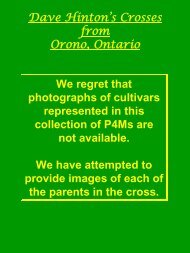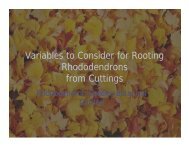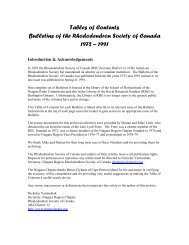{'ie*
RSC Bulletin 1977 v 6-2 - The Rhododendron Society of Canada ...
RSC Bulletin 1977 v 6-2 - The Rhododendron Society of Canada ...
- No tags were found...
You also want an ePaper? Increase the reach of your titles
YUMPU automatically turns print PDFs into web optimized ePapers that Google loves.
Page 20<br />
Now, a large area of fine texture is needed to set off smaller areas of more<br />
vigorous pattern and texture. A lawn has become the commonest of all<br />
groundcover treatments in the average garden but, where soil and climate<br />
permit, it is sometimes very effective to use sheets of low-growing heather,<br />
which fulfills the same basic design requirement - that of producing a large<br />
area of fine texture. Similarly, other plant materials are often better than mown<br />
grass - on a steep bank or in dense shade for instance.<br />
How should one group the broad-leaved'evergreens? lf you are choosing a<br />
rhododendron, chances are 10 to 1 you will first think of the colour of the flower.<br />
You will say: I want a good pink rhododendron. But what you should say is: I<br />
want a rhododendron with broad handsome foliage to blend with other broadleaved<br />
evergreens of smaller foliage. lt's very human to think about plants in<br />
terms of their bloom. But is is foliage size, shape, pattern and colour that make<br />
broadleaved evergreens effective the year round. And you can probably still have<br />
lhe flower colour you want! lf you want a beautiful garden a// the time, you<br />
cannot lay all the emphasis on the colour scheme ol the flowers, for the shrub<br />
will be in bloom, at most, from 3 weeks to a month. What about its appearance<br />
during the other 11 months?<br />
A large-leaved shrub creates a coarse-textured effect, one with small leaves a<br />
fine-textured effect. The most desirable way to combine these foliages in the<br />
garden is to use them in carefully related sequences of foliage sizes. You should<br />
have the same difference between the first foliage size and the second as<br />
between the second and the third, and so on down the line - much like walking<br />
down a flight of stairs, comfortably, without tripping. Foliage sizes must be<br />
grouped so that the stepping in foliage is comfortable to the eye.<br />
Let me give you an example: lf you want to begin with a conifer then, keeping<br />
the scale of your garden picture in mind, decide how coarse or bold textured it<br />
should be and place it as an accent or a specimen. Then build around it a<br />
sequence of foliages, using the coarsest or largest evergreen leaf next to the<br />
conifer. You begin by using a small quantity of coarsest texture, for example the<br />
one rhododendron with leaves of the largest size that you plan to use. Then with<br />
each decrease in foliage size your proportionately increase the quantity of<br />
foliage of smaller size.<br />
Deciduous foliage, which drops each winter, is necessary to the garden picture;<br />
it provides added interest with its colour changes, and a spectacular display of<br />
bloom at some time during the growing season makes some of the deciduous<br />
shrubs indispensable. The garden in which they are used exclusively will have a<br />
light and airy structure, but such a garden will be weak, since it does not have<br />
the strength and permanence which evergreens impart. Deciduous trees and<br />
shrubs are important structural material but must play 2nd fiddle to the broadleaved<br />
evergreens in all but the coldest climates. Deciduous shrubs are<br />
especially useful as a direct background lor herbaceous plants, and deciduous<br />
trees make an important accent rising up through a bank of broad-leaved<br />
evergreen foliage.



